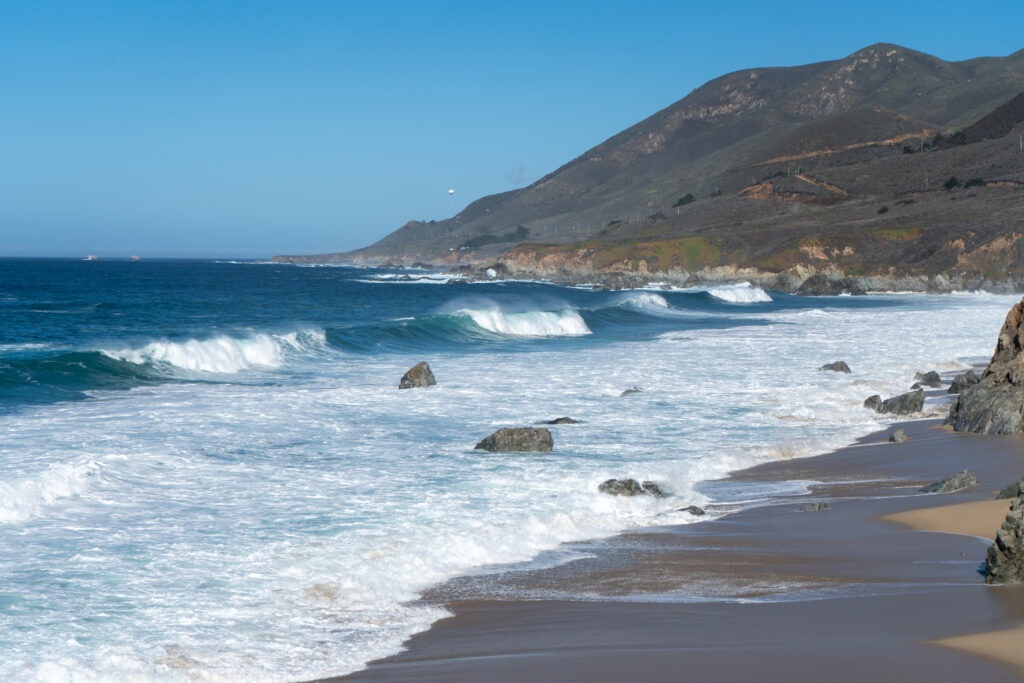Facts about Great White Sharks in the Monterey Peninsula

Habitat
Where do white sharks live? Well, it depends. White sharks inhabit various locations worldwide due to their highly migratory nature. Annually, white sharks off the coasts of California and Mexico gather in what was once considered the Pacific’s desert, now known as “the White Shark Café.” This extensive and seemingly vacant ocean region, situated midway between California and Hawaii, is currently under scrutiny by researchers. Following a research expedition in the spring of 2018, scientists are examining compelling data to ascertain whether the area serves as a feeding ground, a meeting place for white sharks during courtship, or possibly both.
White sharks migrate seasonally to Monterey Bay, returning to California in late summer and early fall after spending months in offshore waters as far west as Hawaii. They congregate in the bay to feed when juvenile elephant seals gather in colonies along the Central Coast. In years with warmer ocean conditions in the bay, sightings of younger white sharks also occur. These sharks, with smaller body masses than adults, don’t fare as well in the colder waters north of Point Conception. They are in the process of transitioning from a juvenile diet of skates, rays, and schooling fishes to the marine mammals, such as seals, which constitute the main food source for adult white sharks.
Size
Big sharks with humble beginnings! White shark pups kick off their aquatic journey at a petite 3.9 to 4.9 feet (1.2 to 1.5 m). As they navigate the ocean of life, these sharks can grow into impressive adults, reaching lengths of up to 20.9 feet (6.4 m). It’s a fin-tastic fact that the ladies usually outsize the gents. Picture this: the grandest reported size for these sea rulers is a whopping 23.5 feet (7 m), with the heavyweight champion tipping the scales at 7,500 pounds! Now, that’s one colossal underwater tale!
Lifespan
Timeless tales of longevity! Male white sharks boast an impressive lifespan, gliding through the waves for up to 73 years. Meanwhile, the leading ladies in the oceanic saga reach a mature age of 40 years.
Diet
In the culinary realm of the deep blue, white sharks shine as renowned predators. Armed with swift bursts of speed, they orchestrate underwater ambushes on their preferred feasts—seals and sea lions take center stage. But the oceanic buffet doesn’t end there; adults savor the flavor of whale carcasses and occasionally indulge in a piscine, ray, or smaller shark delicacy.
As the apex players of the sea, white sharks have few foes. However, our recent deep dives into marine mysteries unveiled a surprising twist—when orcas make a grand entrance, white sharks swiftly vacate the premises.
Human and Shark Incidents.
White sharks do not engage in attacks; instead, they bite. Sharks lack the emotional motives attributed to human actions and do not bite with the intent to “attack.” Demonstrating an effort to comprehend and accurately depict white shark behavior reflects respect for these significant and majestic creatures.
The frequency of white shark bites has seen a notable decrease, as revealed by a recent study conducted by Stanford University and the Aquarium. Over the past 50 years, the likelihood of experiencing a white shark bite in California has dropped by 90 percent.
While enjoying the wild ocean in California is now safer, it remains uncertain whether this decline is due to a reduced white shark population near our coast or a shift in the sharks’ behavior. The recovery of seal and sea lion populations in California, rebounding from near extinction in the late 19th century, might be diverting sharks away from populated beaches and towards extensive seal rookeries along more secluded stretches of the coast.
Written by: Zane Davis – BSA Team, March,4,2024






